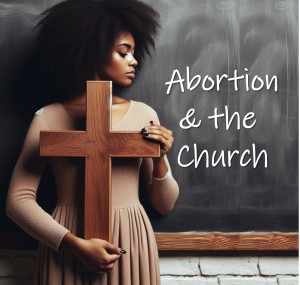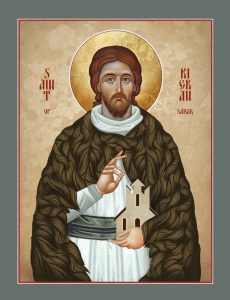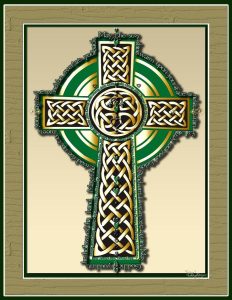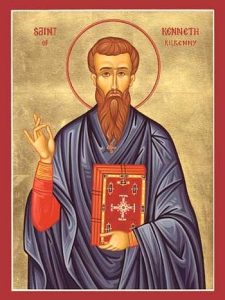 Did you know that Christianity’s stance on abortion has changed over time? Attitudes regarding sexuality and childbirth were markedly different in the past. Hagiographical texts even hold accounts saints performing abortions.
Did you know that Christianity’s stance on abortion has changed over time? Attitudes regarding sexuality and childbirth were markedly different in the past. Hagiographical texts even hold accounts saints performing abortions.
All the saints’ stories carry a similar theme: the abortions are carried out with the blessing of God and recorded as a miracle. If you find yourself shaking your head in incredulity, take a moment to consider that for most of human history abortion was a legal and acceptable way to end unwanted pregnancies.
The most sought-after abortifacient in antiquity was Silphium. It was used across the Mediterranean region and deemed so valuable that the City of Cyrene had its image stamped onto their coins. Ancient Egyptian hieroglyphs depict the plant. Roman poetry declared the herb was worth its weight in gold. Silphium even makes an appearance in the Bible. Not only was abortion permissible in biblical times, but women could be forced to endure abortions against their will. In such cases, priests oversaw the abortions (Numbers 5:11-31) at the behest of the woman’s husband or parents. Thus, it is not surprising that a number of saints also performed abortions.
Since my main area of interest is Celtic culture, I only recount the tales of four Irish saints here. However, there are other saints in other regions who also have abortions attributed to them as miracles. The Irish saints who performed these abortions are Brigid of Kildare, Ciarán of Saigir, Áed mac Bricc, and Cainnech of Aghaboe.
Brigid of Kildare
![]() Saint Brigid of Kildare lived from 451 to 525. She is considered the patroness saint (‘mother saint’) of Ireland. In 480, Brigid founded Kildare Abbey in County Kildare, Ireland. She later went on to establish several other convents. In her honor, a perpetual flame was kept burning at Kildare for centuries. Her feast day is February 1st.
Saint Brigid of Kildare lived from 451 to 525. She is considered the patroness saint (‘mother saint’) of Ireland. In 480, Brigid founded Kildare Abbey in County Kildare, Ireland. She later went on to establish several other convents. In her honor, a perpetual flame was kept burning at Kildare for centuries. Her feast day is February 1st.
Brigid preserved both a laywoman’s and a nun’s virtues in unusual circumstances.
The First Abortion
A woman who lived near the abbey had taken the vow of integrity. Despite this vow, she succumbed to the youthful desire of pleasure, which resulted in an unintended pregnancy. In time, her womb swelled with child, so that she began to show. Wishing to have her honor restored, the woman called at the Abbey.
The Abbess, Brigid, heard the woman’s confession. Exercising the strength of her faith, Brigid blessed her. The blessing caused the swelling in the woman’s abdomen to disappear and conception in her womb to decrease. In doing so, Brigid had restored her to health and returned her to repentance without childbirth or it’s pangs. For this miracle, the woman then gave thanks to God.
The Second Abortion
A nun who lived at the Abbey broke her vow of chastity in a moment of weakness, which resulted in an unwanted pregnancy. When her uterus began to swell and her condition would soon be known, she went to the Abbess, Brigid. Despairing over the pregnancy, the nun begged Brigid for a blessing.
When Brigid blessed the nun’s abdomen, what had been conceived in the womb disappeared. In doing so, Brigid faithfully returned the nun to a life of penance.
In Brigid’s day, inducing an abortion was called “womb-healing.” The pregnant women who visited her were miraculously “healed” of the child in their wombs, restored to health, and made free of sin. This is significant because performing abortions and causing fetuses to vanish clearly was not worthy of condemnation at the time. Further, both stories indicate that the women’s abdomens had already begun to swell with child, which means the abortions were performed well into the second or possibly even the third trimester. Finally, the hagiography is noteworthy, not simply for ability to make pregnancies vanish, but that both of those pregnancies were the results of consensual acts.
If Saint Brigid was alive today, it seems she would be pro-choice. In her place, we have The Brigid Alliance, an American NGO that assists people seeking abortions. It was named after Saint Brigid in reference to these miracles.
Brigid’s Pagan Connections
Brigid of Kildare is the Christian version of the Celtic goddess Brigid. The saint’s feast day is February 1st, which coincides with the pre-Christian Celtic festival of Imbolg, which is associated with the goddess Brigid. The Abby at Kildare was built atop the site of a well sacred to the goddess Brigid. Both the saint and the goddess are patroness of many things, including: poetry, learning, healing, protection, blacksmithing, livestock and dairy production. In addition, the origin story of the goddess and the hagiography of the saint both indicate that Brigid was raised by Druids.
Ciarán of Saigir
 In 530, Saint Ciarán of Saigir, sometimes called Saint Ciarán the Elder, was bishop of Saighir at the church of Seir Kieran, in County Offaly, Ireland. He is listed among the Twelve Apostles of Ireland and miraculously performed an abortion. His Feast Day is March 5th.
In 530, Saint Ciarán of Saigir, sometimes called Saint Ciarán the Elder, was bishop of Saighir at the church of Seir Kieran, in County Offaly, Ireland. He is listed among the Twelve Apostles of Ireland and miraculously performed an abortion. His Feast Day is March 5th.
According to the Lives, the account of the abortion is as follows:
Bruinnech was an exceptionally beautiful nun who had the misfortune of catching the attention of the local petti king, Bruidge mac Nath I. Unable to persuade the nun to break her vows, the king forced himself upon her. Upon hearing of this outrage, and despising the enormity of the crime, Saint Ciarán immediately sought to rectify the situation.
Rather than send “thoughts and prayers,” Saint Ciarán took action. He traveled to the house where the sacrilege took place and collected the nun with the intent of returning her to the safety of the monastery. It was there that he learned she was pregnant.
Being a man of God, and led by the zeal of justice, he wished to restore the virtue and honor of the nun and prevent the serpent’s seed from quickening. To achieve these goals, he performed an abortion for Bruinnech by pressing down on her womb with a cross. This action forced her womb to be emptied.
There are two important items of note here. First, as cited by the Catholic News Agency and Thomas Charles-Edwards, “…the saint’s intervention is directed towards restoring the honor of the woman concerned,” not to preserve the life or health of the mother. The second is the phrase, “prevent the serpent’s seed from quickening.” Quickening is the term used to describe when the movements of a fetus can be felt by the mother. This typically occurs around 20 weeks of pregnancy. By referring to the fetus as “the serpent’s seed,” Saint Ciarán clearly indicates that not all children are a blessing from God, nor should a woman be required to birth them.
Possible Pagan Connection
Some have suggested that Saint Ciarán is a Christianized version of the pagan god Cernunnos. The god shares many similar traits with the saint. Both are heavily connected with forests. Cernunnos is “Lord of the Hunt” and protector of wild places, who is often depicted surrounded by animals. Likewise, Saint Ciarán spent his early years as a hermit, living in forests surrounded by wild animals, who were reputed to have been his first pupils. The animals helped Ciarán construct his home in the woods. As a result, the saint always remembered them as being the first monks to inhabit his monastery.
Unfortunately, the connection between Cernunnos and Saint Ciarán is tenuous at best. Cernunnos is primarily a Gaulish deity and there is no evidence that he was ever worshiped in Ireland. The tribe most likely to worship him, the Carnutes, were primarily centered in Gaul and Germania—they never migrated past what is modern-day England.
Áed mac Bricc
 Saint Áed’s principal church was at Rahugh in County Westmeath, Ireland, however, he later served as Bishop of Kildare. Owing to his ability to heal headaches, he is the patron saint of headache suffers. Saint Áed died in 589 and his feast day is November 10th.
Saint Áed’s principal church was at Rahugh in County Westmeath, Ireland, however, he later served as Bishop of Kildare. Owing to his ability to heal headaches, he is the patron saint of headache suffers. Saint Áed died in 589 and his feast day is November 10th.
The life of Áed is interesting in that he was raised by a single mother in a rustic setting, spending his early years among humble folk. During his adolescence, his father died. This required him to travel to his father’s village to claim his inheritance. But when he arrived, his brothers refused to part with his share of the land.
Angered at being denied access to his inheritance, Áed carried off a maid servant who belonged to his brothers in hopes of forcing them to relinquish his share of the estate. It was at this time that he met Bishop Illann, who convinced him to give up his claim to the land and let the girl go. It is not surprising then, that the central concerns of Saint Áed’s vita are the poverty and insecurity of women, especially nuns, as his early life left him with a profound interest in the well-being of women.
As Bishop, Áed frequently visited settlements of nuns and holy virgins, where he was often received with hospitality and great joy. During one visit to Druim Ard, he noticed that the woman serving him was pregnant and her abdomen was noticeably swelling with child. To avoid being polluted by her shame, Áed fled the building without eating the meal that had been set before him.
Embarrassed by Áed’s rebuff, she confessed to all, stating that she had secretly sinned and agreed to make penance. However, Áed was not about to leave someone under his care in a difficult situation. He returned and blessed her womb. The infant growing in her belly disappeared as if it had never been.
Cainnech of Aghaboe
 Saint Cainnech of Aghaboe was also known as Saint Canice in Ireland and Saint Kenneth in Scotland. As the child born to a famous bard, he lived from 515 to 600. He is one of the Twelve Apostles of Ireland and wrote a commentary on the Gospels, known as the Glas-Choinnigh or Chain of Cainnech. He is the patron saint of the shipwrecked and his feast day is October 11th.
Saint Cainnech of Aghaboe was also known as Saint Canice in Ireland and Saint Kenneth in Scotland. As the child born to a famous bard, he lived from 515 to 600. He is one of the Twelve Apostles of Ireland and wrote a commentary on the Gospels, known as the Glas-Choinnigh or Chain of Cainnech. He is the patron saint of the shipwrecked and his feast day is October 11th.
In 543, Cainnech became a pupil at Finnian’s monastic school a Clonard. By 550, he had achieved the rank of monk and traveled widely throughout Ireland and Scottland, eventually founding the monastery of Achad Bó in Osraige, Aghaboe County, Ireland and served as its first abbot. Cainnech was considered a man of virtue, eloquence, and learning. He also has an abortion miracle recorded in his hagiography, although the account is brief.
A certain nun living in Cainnech of Aghaboe’s neighborhood secretly committed fornication. In time, her womb began to grow with the child conceived. She asked Saint Cainnech to bless her belly, pretending that it was swollen by some ailment or pain. When he blessed her, the infant in her womb vanished, not appearing.
The interesting part of this tale is that the nun had attempted to deceive Cainnech. It does not say how he determined she was pregnant or how he knew that she sought an abortion. Regardless, an abortion was performed and recorded as a miracle attributed to the saint.
When evaluating the abortion tales of these four saints, it is not insignificant that, with the exception of Bruinnech, who was raped, none of the other women are named. This indicates that procuring an abortion was seen as a private matter, known only to the woman, her confessor, and God.
Penance for Abortion
Saints weren’t the only ones performing abortions. That’s because abortion was legal at the time.
While abortion was legal, with the exception of those performed by the abortionist saints, it was still viewed as a sin. The sixth-century Penitential of Finnian, the seventh-century Irish Canons, and the eighth-century Old Irish Penitential all list abortion among the sins to be repented.
A penitential lists specific sins and corresponding penances. The penances ranged from fasting for a specified amount of time to flogging or physically punishing oneself. Further, the severity of the fasts varied from a diet of bread and water to simply abstaining from wine. Early penitentials often imposed equal penances for both early-term and late-term abortions.
While modern Catholic moral teaching depicts abortion as a major sin, historically it was comparatively low-ranking. It was best if people never fornicated but, if they did and a pregnancy ensued, a nun or saint could abort the fetus. Thus, the women who received such miracles completed penance for engaging in “youthful pleasure” rather than obtaining the abortion.
In the Penitential of Finnian, the atonement required for an abortion is a fraction of the time for having a child out of wedlock. Accordingly, if a woman obtained an abortion, her penance was six months of bread and water, followed by abstaining from meat and wine for two years. But if she birthed the child and her sin was manifest, her penance was six years of bread and water. In the seventh year, she could come to the altar and have her honor restored.
Canons Theodori is a penitential handbook based on the judgements of Archbishop Theodore of Canterbury between 668 and 690. A partial list of sexual sins recorded by Archbishop Theodore and the required length of penance for each is listed below:
- Fellatio, Life
- Incest, 7 to 12 years
- Adultery, 4 years
- Fornication with a virgin, 4 years
- Masturbation, 3 years
- Married twice, 1 year
- Abortion, 1 year
When looking at greater sins, fellatio stands out in Theodore’s penitential. The exact verbiage from his penitential is, “Whoever ejaculates seed into the mouth, that is the worst evil…they repent this up to the end of their lives.” In addition, deliberately obtaining an abortion was seen as grounds for divorce.
Many sources taken together, herbals, trial records, and Materia Medica, reveal that midwives and the women themselves possessed extensive knowledge of abortion inducing herbs. A woman often first sought to ‘put herself right’ by drinking infusions of one of the traditional abortifacients. In Ireland, herbs such as motherwort, black briony, honeysuckle, tansy, pennyroyal, rue, black hellebore, ergot of rye, savin, and sow bread were all used to induce abortions.
Ensoulment
While abortion was viewed as a sexual sin, it was not akin to murder. That’s because embryos were not considered “alive” until they were animated by a human soul during a process called ensoulment. In On Virginal Conception and Original Sin, Anselm of Canterbury (1033–1109) said “no human intellect accepts the view that an infant has the rational soul from the moment of conception.” A few decades after Anselm’s death, a Catholic collection of cannon law in the Decretum Gratiani stated, “he is not a murderer who brings about abortion before the soul is in the body.”
According to Mosaic law, a fetus doesn’t become human until the head emerges from the womb. Before that, “the fetus is the thigh of its mother.” Thus, it is not considered an independent being, but a “partial life.” This view is based on Exodus 21:22-25.
Exodus 21:22–25
If men, while fighting, do damage to a woman with child, causing the loss of the child, but no other evil comes to her, the man will have to make payment up to the amount fixed by her husband, in agreement with the decision of the judges. But if damage comes to her, let life be given in payment for life, eye for eye, tooth for tooth, hand for hand, foot for foot, burning for burning, wound for wound, blow for blow.
Since Mosaic law requires “a life for a life,” the above scenario implies that a fetus has value, but its value is not equal to that of a human life, otherwise the offender’s punishment would have been death.
Consequently, the doctrine of Creationism teaches that the soul is introduced to a fetus by God at the time of its first breath. This is based off of Genesis 2:7, which says, “God formed a man from the dust of the ground and breathed into his nostrils the breath of life.” Ecclesiastes 12:7 adds, “the dust returns to the ground it came from, and the spirit returns to God who gave it.”
The Church after the Saints
It wasn’t until October 28, 1588, that Pope Sixtus V issued a papal bull decreeing that abortion at any stage of pregnancy was homicide. This was both a theological dictate and a criminal law. Anyone who sought, performed, or aided in an abortion was excommunicated and only able to seek forgiveness by travelling to Rome.
Bishops and vicars immediately began writing the Pope, asking for clarifications and special permission to absolve violators. The volume of requests for exemptions made it clear that the papal bull was unenforceable. Consequently, law was only in effect for three years.
After Sixtus’s death in 1590, Pope Gregory XIV quickly rolled back the dictate, returning to the less-harsh penalties of the holy cannons. On May 31, 1591, new regulations regarding abortions were published in the apostolic constitution Sedes Apostolica, which stated, “those who abort an inanimatus [soulless fetus] will not be guilty of homicide because they have not killed a human being in actuality.” The Sedes Apostolica remained in effect for almost three centuries.
As late as the 17th century, Francis Torreblanca approved abortions for the purpose of saving a woman’s good name, stating, “it is lawful to procure abortion before ensoulment of the fetus lest a girl, detected as pregnant, be killed or defamed.”
Abortion was not banned in Ireland until 1861 with the passage of the Offenses against the Person Act. Then, in 1869, Pope Pius IX issued the papal bull, Apostolicae Sedis Moderation, which rescinded Gregory XIV’s not-yet-ensouled exception, declaring that those who procured an abortion incurred excommunication. This act represented a sharp departure from nearly 2000 years of precedent regarding the Church’s stance on abortion.
To learn more about the history of abortion, particularly as it relates to America, see: Emmenagogues and Abortifacients | Khaliela Wright
References
Callan, Maeve. “Of Vanishing Fetuses and Maidens Made-Again: Abortion, Restored Virginity, and Similar Scenarios in Medieval Irish Hagiography and Penitentials.” Journal of the History of Sexuality, Vol 21, No 2. May 2012. p. 282-296
(utexaspressjournals.org)
Emmons, Jim B. Translation of the Vita Aidi/The Life of St. Áed mac Bricc. 2002
The Life of St. Áed mac Bricc | JBT Emmons – Academia.edu
Givens, Madison. Abortion, Medieval Christianity, and the Christian Far-Right: The Harms of Rhetoric and Misconstruing the Past. Master’s Thesis. Loyola University of Chicago. Chicago, IL. May 2023.
viewcontent.cgi (luc.edu)
Márkus, Gilbert. The Life of St Cainnech of Aghaboe. Translation and notes. October 2018.
Vita-Sancti-Cainnechi-with-GM-translation-and-notes.pdf (uistsaints.co.uk)
McNeil, John T. and Helen Garmer. “The Penitential of Finnian.” Medieval Handbooks of Penance. New York: Columbia University Press, 1938.
Microsoft Word – Document25 (weebly.com)
Monk, Molly. “The History of Catholic Teaching on Abortion isn’t as Clear-Cut as You Think.” The Outline. Published: Jan. 16, 2020
The history of Catholic teaching on abortion isn’t as clear cut as you think | The Outline
Murphy, E. M. ‘The Child that is Born of One’s Fair Body’ – Maternal and Infant Death in Medieval Ireland. Childhood in the Past, 14(1). May 2021. p. 13-37. https://doi.org/10.1080/17585716.2021.1904595